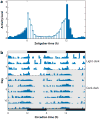Circadian organization of behavior and physiology in Drosophila
- PMID: 20148690
- PMCID: PMC2887282
- DOI: 10.1146/annurev-physiol-021909-135815
Circadian organization of behavior and physiology in Drosophila
Abstract
Circadian clocks organize behavior and physiology to adapt to daily environmental cycles. Genetic approaches in the fruit fly, Drosophila melanogaster, have revealed widely conserved molecular gears of these 24-h timers. Yet much less is known about how these cell-autonomous clocks confer temporal information to modulate cellular functions. Here we discuss our current knowledge of circadian clock function in Drosophila, providing an overview of the molecular underpinnings of circadian clocks. We then describe the neural network important for circadian rhythms of locomotor activity, including how these molecular clocks might influence neuronal function. Finally, we address a range of behaviors and physiological systems regulated by circadian clocks, including discussion of specific peripheral oscillators and key molecular effectors where they have been described. These studies reveal a remarkable complexity to circadian pathways in this "simple" model organism.
Figures




References
Publication types
MeSH terms
Grants and funding
LinkOut - more resources
Full Text Sources
Molecular Biology Databases

